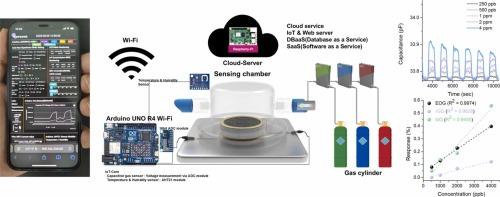IoT-Enabled capacitive ammonia sensor platform for real-time environmental monitoring at room temperature
IF 3.7
1区 化学
Q1 CHEMISTRY, ANALYTICAL
引用次数: 0
Abstract
We report a capacitive-type ammonia (NH₃) gas sensor integrated with an internet of things (IoT)-based platform for real-time environmental monitoring at room temperature. This is the first demonstration of a capacitive NH₃ sensor, offering lower power consumption and faster response compared to conventional chemiresistive sensors. The sensor employs a vertically aligned exfoliated graphene oxide (EOG) film (∼4 μm thick) with porous microchannels that enhance dielectric polarization and gas diffusion. Structural analyses confirmed multilayer graphene domains with restored sp² networks, while surface functional groups (C–OH, C![]() O) facilitated hydrogen bonding with NH₃, enabling reversible adsorption–desorption. The EOG sensor showed a rapid response time of 45 s and recovery time of 64 s at 4 ppm NH₃, with high linearity (R² = 0.997) over a range of 0.5–4 ppm and a calculated limit of detection (LOD) of approximately 111 ppb. It also exhibited lower resistance (100 kΩ) and capacitance (33.77 pF), resulting in faster charge polarization and improved response. The sensor data were transmitted wirelessly via Wi-Fi to a Raspberry Pi-based cloud server and visualized using a custom web/mobile interface. This study demonstrates a novel capacitive gas-sensing platform with integrated IoT functionality that offers a promising solution for portable and energy-efficient gas detection systems.
O) facilitated hydrogen bonding with NH₃, enabling reversible adsorption–desorption. The EOG sensor showed a rapid response time of 45 s and recovery time of 64 s at 4 ppm NH₃, with high linearity (R² = 0.997) over a range of 0.5–4 ppm and a calculated limit of detection (LOD) of approximately 111 ppb. It also exhibited lower resistance (100 kΩ) and capacitance (33.77 pF), resulting in faster charge polarization and improved response. The sensor data were transmitted wirelessly via Wi-Fi to a Raspberry Pi-based cloud server and visualized using a custom web/mobile interface. This study demonstrates a novel capacitive gas-sensing platform with integrated IoT functionality that offers a promising solution for portable and energy-efficient gas detection systems.

用于室温下实时环境监测的物联网电容式氨传感器平台
我们报告了一种电容式氨(NH₃)气体传感器,该传感器与基于物联网(IoT)的平台集成在一起,用于室温下的实时环境监测。这是电容式NH₃传感器的首次演示,与传统的化学电阻式传感器相比,它具有更低的功耗和更快的响应速度。该传感器采用垂直排列的剥离氧化石墨烯(EOG)薄膜(约4 μm厚),具有多孔微通道,可增强介质极化和气体扩散。结构分析证实了多层石墨烯畴具有恢复的sp²网络,而表面官能团(C - oh, C=O)促进了与NH₃的氢键,实现了可逆的吸附-脱附。EOG传感器在4 ppm NH₃下的快速响应时间为45 s,恢复时间为64 s,在0.5-4 ppm范围内具有高线性(R²= 0.997),计算出的检测限(LOD)约为111 ppb。它还具有更低的电阻(100 kΩ)和电容(33.77 pF),从而实现更快的电荷极化和更好的响应。传感器数据通过Wi-Fi无线传输到基于Raspberry pi的云服务器,并使用自定义web/移动界面进行可视化。该研究展示了一种具有集成物联网功能的新型电容式气敏平台,为便携式节能气体检测系统提供了一种有前途的解决方案。
本文章由计算机程序翻译,如有差异,请以英文原文为准。
求助全文
约1分钟内获得全文
求助全文
来源期刊

Sensors and Actuators B: Chemical
工程技术-电化学
CiteScore
14.60
自引率
11.90%
发文量
1776
审稿时长
3.2 months
期刊介绍:
Sensors & Actuators, B: Chemical is an international journal focused on the research and development of chemical transducers. It covers chemical sensors and biosensors, chemical actuators, and analytical microsystems. The journal is interdisciplinary, aiming to publish original works showcasing substantial advancements beyond the current state of the art in these fields, with practical applicability to solving meaningful analytical problems. Review articles are accepted by invitation from an Editor of the journal.
 求助内容:
求助内容: 应助结果提醒方式:
应助结果提醒方式:


